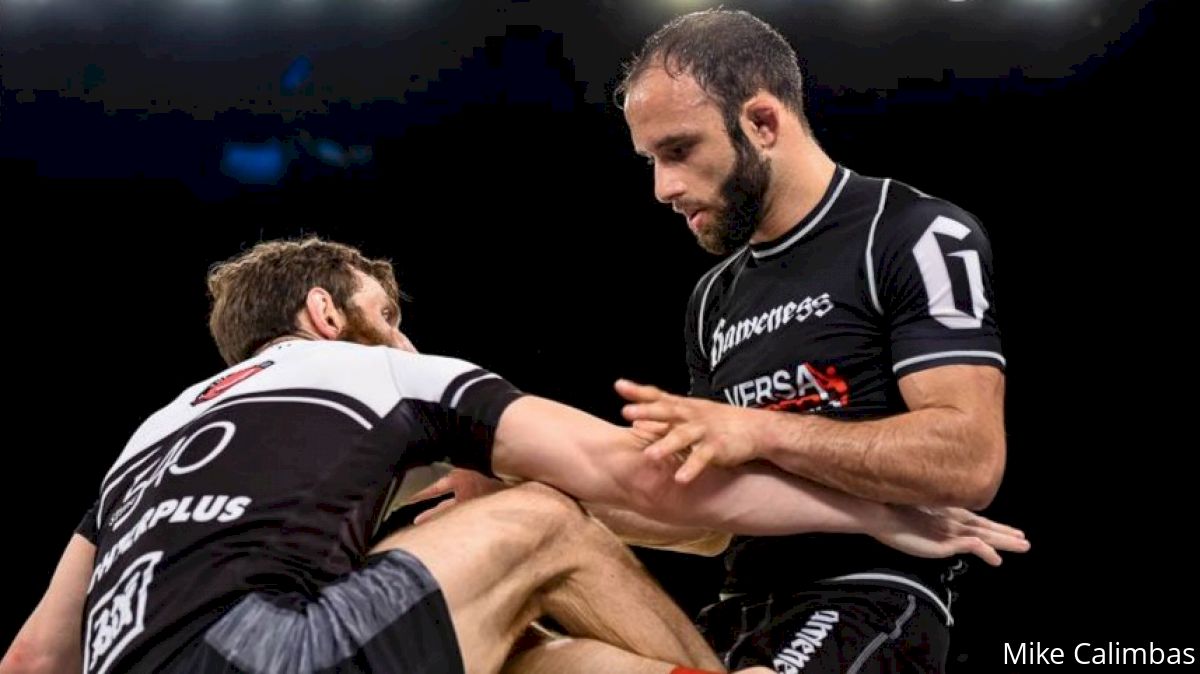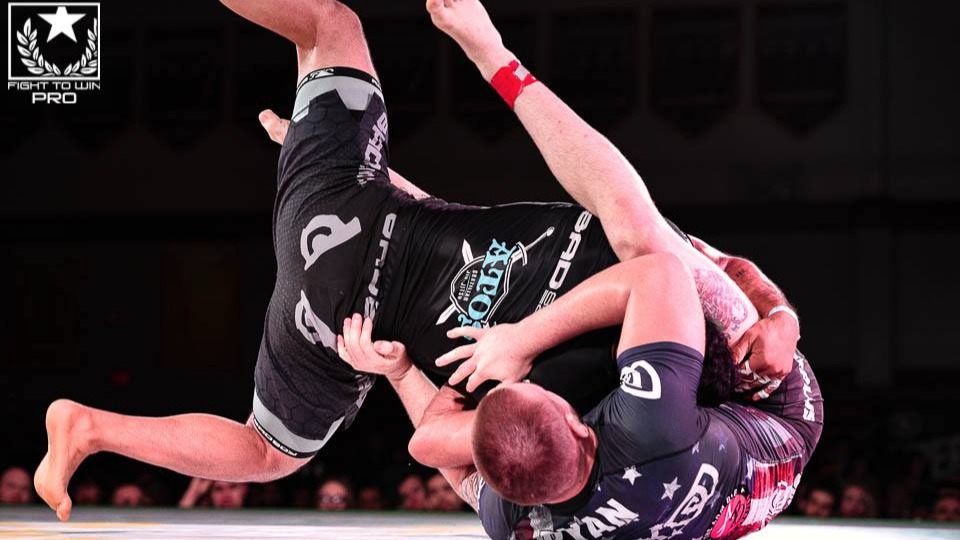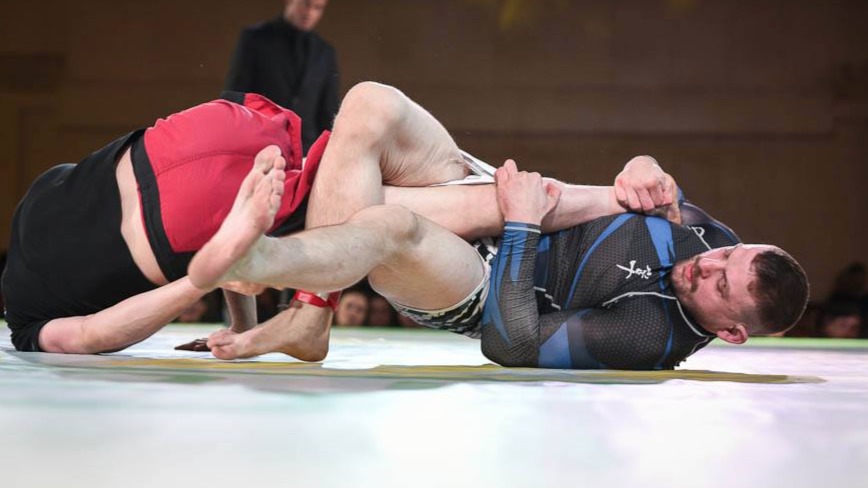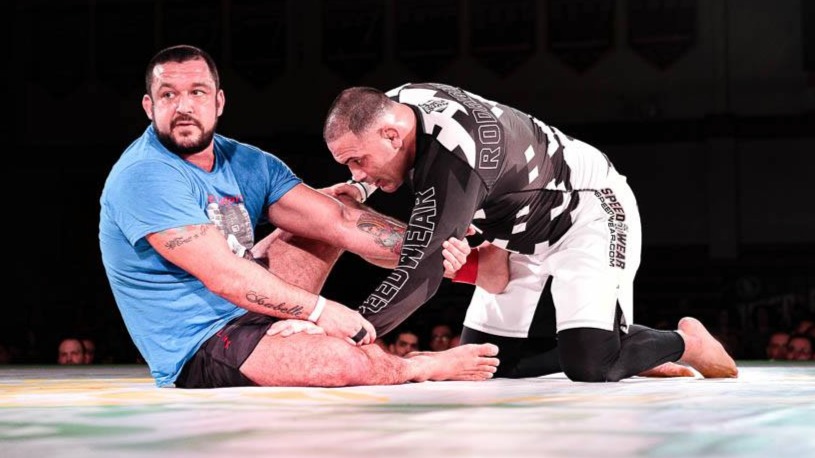The Top Player's Burden In Submission-Only Matches
The Top Player's Burden In Submission-Only Matches
In the past few years, we have witnessed an explosion of submission-only competitions. However, even submission-only matches are not without their own controversy.

IBJJF rules, ADCC rules, submission-only rules, so many rules. Over the past 20 years of jiu-jitsu competition, growing discontent with the various point systems created a market for submission-only tournaments.
In the past few years, we have witnessed an explosion of submission-only competitions. However, even submission-only matches are not without their own controversy.
Here's my problem with submission-only rules and their consequential judges decisions. In my experiences, I have heard a great many people complain about the rule of advantages in the IBJJF point system.
From what I understand, these complaints are based on a belief that it is ridiculous to decide a match with a tie score by tracking how many times they "almost" accomplished submission attacks or positional advancements. However, when sub-only innovators decided to create a new submission-only rule set, what they did is actually just empower the advantage point, decrease the value of the positional points, and take away the scoreboard so that no one can see who is winning in real time.
In the event that a match lasts the entire time period without a submission, the judges base their decision first on submission attempts (aka "almost submissions"), which hold the highest value for deciding a winner. Positional advancements (aka standard points) are tracked with a secondary value and are considered when there were no significant submission attacks or the number of submission attacks is equal between the competitors.
Lastly, unsuccessful positional advancement attempts (aka "almost takedowns," "almost sweeps," and "almost guard passes") are tracked as the last tie-breaking measurement of aggressiveness when there are no other significant measurements from which to judge the match. The most important takeaway here is that the submission advantage is the most powerful deciding factor in a judges' decision of a sub-only match that did not end in a decisive submission victory.

Lucas "Hulk" attempts to pass Gordon Ryan's guard. Photo: Mike Calimbas
Now let's consider how the grappling match might start. Two grapplers come out of their corners, and one immediately sits to his butt while the other stays standing. The bottom player is able to immediately engage in submission hunting. From the bottom position, there are triangles, armbars, omoplatas, leg locks, etc.
The bottom player has very little incentive to execute or even attempt a sweep. Sweeps or "almost sweeps" hold little value to the judges, AND many sweeps will put you into the guard of the opponent. This means the bottom player will go from a relatively safe position (bottom with easy access to many submissions) to a position of danger -- that being in someone's guard.
Of course, it is possible to sweep someone to mount or side control, but at the higher levels of jiu-jitsu, practitioners are commonly able to recover the guard in the event that they are swept. Being in the guard is dangerous, because you are constantly under attack until you pass it. This brings us to "the top player's burden."
The top player's burden is that he or she must pass the guard in order to attack the majority of submissions that are readily available to the bottom player -- namely armbars, triangles, various types of "platas," RNC, kimuras (granted these can be attacked from a half-guard smash position, although in many cases the kimura is secured, the guard is then passed and lastly the kimura is finished.) The only set of submissions available to the top player who chooses not to pass the guard is the leg locks.

Joe Baize goes for a leglock. Photo: Mike Calimbas
However, the top players can successfully execute very few leg locks while he or she maintains the standing position (the exception being the estima lock). Usually, the top player needs to latch onto the foot or leg, fall back to the mat, and proceed to apply pressure in order to finish the submission. Essentially, the top player needs to sit to a double-guard position in order to attack the leg. So what is the incentive for the top player to stay on top?
If he or she wants to attack leg locks, it is most logical for him to double guard pull at the same time as his guard pulling opponent. This is, of course, the worst situation for jiu-jitsu spectators. In my opinion, and the opinion of many others, the double-guard pull makes for one of the most ugly and most unentertaining forms of jiu-jitsu known to man (second only to 50-50 sweeping battles).
If the top player stays on top he risks more than the bottom player. In order to pass the guard, he or she must defend the bottom player's plethora of submission attacks. While many stubborn guard passers do not mind dancing through a submission minefield in order to put some shoulder smash on Mr. Butt-Scooter's face, it is in fact a less than favorable strategy considering that the judges will be counting the number of submission attempts the bottom player is able to throw at the guard passer as he or she is passing the guard.
In situations like this, whether the match takes place in a gi or no gi plays a substantial role. It is in fact much more difficult to control an opponent in a no-gi match. It is decidedly easier to escape bad positions if there is no gi on which to hold.
The point here being that if a top player was able to pass the guard of the bottom player, he or she would likely only get one good chance to attack a submission before losing his position in a scramble and returning to the bottom player's guard. The gi makes it much easier to attack submissions without losing the entire position if a submission attempt fails.
So I pose this question: in a nogi sub-only match judged mainly by submission attempts (aka submission advantages), what incentive does a competitor have to stay on top and try to pass the guard? Why shouldn't he or she just double-guard pull with the bottom player in order to minimize his or her exposure to the wider variety of submission threats that are present when trying to pass the guard? I don't know the answer to this.
In my opinion, the reason is because top players are game for putting on an exciting match. They aren't willing to sacrifice the entertainment value of their match for the sake of minimizing potential threats. So in my opinion, when judging a match, it should be taken into consideration that the top player is the active aggressor. The fact that top players cannot immediately attack submissions because they are busy passing the guard should not be held against them simply because they refuse to double-guard pull and chase the ankles from the beginning. However, the way the rules are set up, the top player will always be at an immediate disadvantage to the guard puller.
Additionally, with a scoreboard the referees and judges are more accountable for their decisions as everyone gets to see when and for what points or advantages are awarded. Taking away the scoreboard did nothing for the sport except create more controversy and disgruntled spectators who do not understand how judges are coming to their conclusions.

Tom Deblass vs Ricco Rodriguez. Photo: Mike Calimbas
This would require that the guard puller make some significant contact and effort to engage the opponent with their guard instead of passively waiting for the top player to engage them. Recently, on F2W Pro 30, Tom DeBlass made a fine example of how when his opponent refused to engage his guard, he immediately jumped up and chased down his opponent and engaged him on his feet.
I believe the spectators are tired of watching uneventful guard pulls and top players who are constantly avoiding dangerous guards and resetting their passing positions. I am not suggesting that guard pulling be penalized, NOR can we force the top player to stay in the guard while the guard player sets up an attack. Bottom players complain that top players run away, top players complain that guard pullers are afraid to grapple on the feet and fight for takedowns.
The reality is if you don't want someone to run away from you, you should be able to execute a takedown and control them. They can't run away if they are on their backs.
In the past few years, we have witnessed an explosion of submission-only competitions. However, even submission-only matches are not without their own controversy.
Here's my problem with submission-only rules and their consequential judges decisions. In my experiences, I have heard a great many people complain about the rule of advantages in the IBJJF point system.
From what I understand, these complaints are based on a belief that it is ridiculous to decide a match with a tie score by tracking how many times they "almost" accomplished submission attacks or positional advancements. However, when sub-only innovators decided to create a new submission-only rule set, what they did is actually just empower the advantage point, decrease the value of the positional points, and take away the scoreboard so that no one can see who is winning in real time.
In the event that a match lasts the entire time period without a submission, the judges base their decision first on submission attempts (aka "almost submissions"), which hold the highest value for deciding a winner. Positional advancements (aka standard points) are tracked with a secondary value and are considered when there were no significant submission attacks or the number of submission attacks is equal between the competitors.
Lastly, unsuccessful positional advancement attempts (aka "almost takedowns," "almost sweeps," and "almost guard passes") are tracked as the last tie-breaking measurement of aggressiveness when there are no other significant measurements from which to judge the match. The most important takeaway here is that the submission advantage is the most powerful deciding factor in a judges' decision of a sub-only match that did not end in a decisive submission victory.

Lucas "Hulk" attempts to pass Gordon Ryan's guard. Photo: Mike Calimbas
Now let's consider how the grappling match might start. Two grapplers come out of their corners, and one immediately sits to his butt while the other stays standing. The bottom player is able to immediately engage in submission hunting. From the bottom position, there are triangles, armbars, omoplatas, leg locks, etc.
The bottom player has very little incentive to execute or even attempt a sweep. Sweeps or "almost sweeps" hold little value to the judges, AND many sweeps will put you into the guard of the opponent. This means the bottom player will go from a relatively safe position (bottom with easy access to many submissions) to a position of danger -- that being in someone's guard.
Of course, it is possible to sweep someone to mount or side control, but at the higher levels of jiu-jitsu, practitioners are commonly able to recover the guard in the event that they are swept. Being in the guard is dangerous, because you are constantly under attack until you pass it. This brings us to "the top player's burden."
The top player's burden is that he or she must pass the guard in order to attack the majority of submissions that are readily available to the bottom player -- namely armbars, triangles, various types of "platas," RNC, kimuras (granted these can be attacked from a half-guard smash position, although in many cases the kimura is secured, the guard is then passed and lastly the kimura is finished.) The only set of submissions available to the top player who chooses not to pass the guard is the leg locks.

Joe Baize goes for a leglock. Photo: Mike Calimbas
However, the top players can successfully execute very few leg locks while he or she maintains the standing position (the exception being the estima lock). Usually, the top player needs to latch onto the foot or leg, fall back to the mat, and proceed to apply pressure in order to finish the submission. Essentially, the top player needs to sit to a double-guard position in order to attack the leg. So what is the incentive for the top player to stay on top?
If he or she wants to attack leg locks, it is most logical for him to double guard pull at the same time as his guard pulling opponent. This is, of course, the worst situation for jiu-jitsu spectators. In my opinion, and the opinion of many others, the double-guard pull makes for one of the most ugly and most unentertaining forms of jiu-jitsu known to man (second only to 50-50 sweeping battles).
If the top player stays on top he risks more than the bottom player. In order to pass the guard, he or she must defend the bottom player's plethora of submission attacks. While many stubborn guard passers do not mind dancing through a submission minefield in order to put some shoulder smash on Mr. Butt-Scooter's face, it is in fact a less than favorable strategy considering that the judges will be counting the number of submission attempts the bottom player is able to throw at the guard passer as he or she is passing the guard.
Guard passing in submission-only
If the guard passer fails to pass the guard, he or she is sure to lose the match since the bottom player would have many opportunities during the passing sequences to attack submissions. If the top player does pass the guard and takes side control, the mount, or the back, he or she then must at minimum launch an equal amount of threatening submission attempts at the opponent in order to level out the invisible scoreboards that exists only in the mind of the judges. If he or she can do this, then the top player is likely to win the match based on positional dominance.In situations like this, whether the match takes place in a gi or no gi plays a substantial role. It is in fact much more difficult to control an opponent in a no-gi match. It is decidedly easier to escape bad positions if there is no gi on which to hold.
The point here being that if a top player was able to pass the guard of the bottom player, he or she would likely only get one good chance to attack a submission before losing his position in a scramble and returning to the bottom player's guard. The gi makes it much easier to attack submissions without losing the entire position if a submission attempt fails.
So I pose this question: in a nogi sub-only match judged mainly by submission attempts (aka submission advantages), what incentive does a competitor have to stay on top and try to pass the guard? Why shouldn't he or she just double-guard pull with the bottom player in order to minimize his or her exposure to the wider variety of submission threats that are present when trying to pass the guard? I don't know the answer to this.
In my opinion, the reason is because top players are game for putting on an exciting match. They aren't willing to sacrifice the entertainment value of their match for the sake of minimizing potential threats. So in my opinion, when judging a match, it should be taken into consideration that the top player is the active aggressor. The fact that top players cannot immediately attack submissions because they are busy passing the guard should not be held against them simply because they refuse to double-guard pull and chase the ankles from the beginning. However, the way the rules are set up, the top player will always be at an immediate disadvantage to the guard puller.
"No points" matches are pointless
The points exist in the minds of the referees, judges, and spectators. Whether they are counting legitimate submission attacks or counting the positional dominance, the points exist. The only problem is that there is no standard to keep everyone on the same page. The spectators and the judges are subjectively tracking their own points in their own minds. At least with a scoreboard, competitors and corner men know who is winning and who is losing at every moment of the match and by how much.Additionally, with a scoreboard the referees and judges are more accountable for their decisions as everyone gets to see when and for what points or advantages are awarded. Taking away the scoreboard did nothing for the sport except create more controversy and disgruntled spectators who do not understand how judges are coming to their conclusions.

Tom Deblass vs Ricco Rodriguez. Photo: Mike Calimbas
A possible alternative
I would suggest a limited amount of time for guard pullers to be on their butts without any significant action. If they are unable to engage and control their opponents, I think a stand-up rule would make for more engaging matches. For example, one minute of non-significant action requires a stand up, and after three stand ups, no more guard pulling is allowed.This would require that the guard puller make some significant contact and effort to engage the opponent with their guard instead of passively waiting for the top player to engage them. Recently, on F2W Pro 30, Tom DeBlass made a fine example of how when his opponent refused to engage his guard, he immediately jumped up and chased down his opponent and engaged him on his feet.
I believe the spectators are tired of watching uneventful guard pulls and top players who are constantly avoiding dangerous guards and resetting their passing positions. I am not suggesting that guard pulling be penalized, NOR can we force the top player to stay in the guard while the guard player sets up an attack. Bottom players complain that top players run away, top players complain that guard pullers are afraid to grapple on the feet and fight for takedowns.
The reality is if you don't want someone to run away from you, you should be able to execute a takedown and control them. They can't run away if they are on their backs.